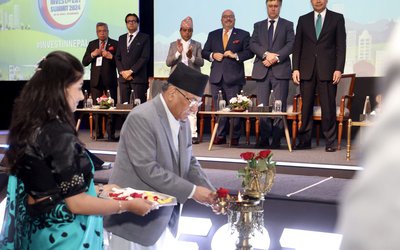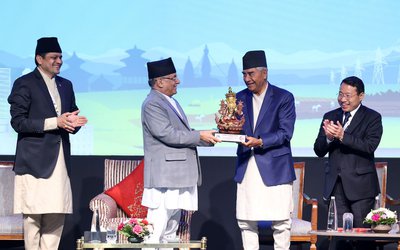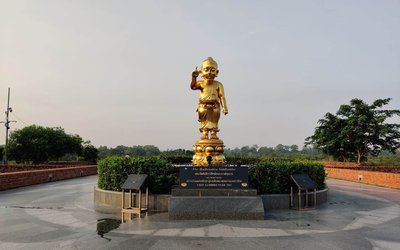The avowed theology of Marxism followed by Prachanda and Baburam condemns religion as “opium of the masses”. During the years of insurgency, they sanctioned the desecration of temples and the execution of Sanskrit teachers. Ironically, they are now competing to capture the “vanguardship” of Buddha’s Lumbini. A Maoist minister, Comrade Rayamajhi, has announced his return to daura-surwal as the national dress, “because it is the dress not of kings but that of Bhakti Thapa and Balabhradra”. The common Nepali is left wondering if it is genuine epiphany or crass electoral opportunism that motivates these worthies.
The three alleged “achievements” of the 2005 Delhi-brokered regime change were republicanism, federalism and secularism. All the big parties have now backed away from ethnic federalism and are looking for a face-saving exit even as surveys show that “ethnic self-determination” is on the wane even among Madhesis and Janajatis. On republicanism, the nation is evenly and passionately divided between those who want loktantra with constitutional monarchy and those who don't. When it comes to secularism, those who prefer a Hindu state have remained consistently between 56 and 60 percent in all the eight surveys since 2004. While a Hindu state is the unsurprising preference of about 70% of those who prefer a constitutional monarchy, it is amazing that those who prefer republicanism are evenly divided, 49:49, between secularism and a Hindu state.
These results, and its pressures on loktantra's politicians, are hardly surprising given that 80% of the people identify themselves as Hindu. They point to the fact that the imperatives of modernism, which may charitably be said to underlie the declaration of secularism, cannot be settled by a referendum and should never have been allowed to enter the domain of competitive electoral politics where only minorities lose out. The uncharitable, widely-accepted hearsay of course is that the leaders of all big parties, anxious as they were to undercut a Hindu king's position, were additionally encouraged into declaring secularism by moneyed proselytizers. Given that it was thrust upon the country without any public debate, it has created a sense of insult among the majority and paved the way for a hitherto unheard of, unfortunate and wholly unnecessary rise in fundamentalism that will make it so much harder to argue for reforms in the archaic way that Hindu rituals are currently practised.
Understanding what roils Nepali society on this front is not easy; but a book has appeared edited by Craig Calhoun and colleagues of the Social Science Research Council of New York called Rethinking Secularism, which provides insights into the nature of the beast and the pitfalls ahead. (It was Calhoun as president of SSRC who helped Social Science Baha and Martin Chautari produce the seminal 2004 Nepali publication Social Science Reflections in the Nepali Context.) The authors argue that secularism cannot be seen as separate from the struggles of European Christian history, which points to its origin and practices that are far from its current liberal understanding. The very word “religion” did not exist before the 18th Century Enlightenment, the preferred words being “faith” or “tradition”, much the same as dharma is used in the Hindu-Buddhist sense. It was created to define Enlightenment's antagonism to the power of the clergy and its ownership of vast tracts of land.
The word “secular” is old and of Etruscan origin. It was borrowed by the Romans to denote a lifetime, and was used in early Church to distinguish between spiritual clergy (monks) from those who served parish rituals and administration (priests), much as sanyasis are distinguished from purohits in Hinduism. The concept of the separation of the political state from religious functionaries has a long history in early Christianity, Islam and other world religions. The market is seen as the best example of a secular institution outside of religious faith, and the modern understanding of secularism is in no small measure its contribution since the mid-19th Century. Unfortunately, it “implies a progressive and final disappearance of the religions” without any firm basis for ethical practice.
Calhoun and colleagues argue that, contrary to popular belief, the Peace of Westphalia in 1648 was not the beginning of secularism but the acceptance of the principle cuius regio eius religio (who rules, his religion). It led to massive ethnic cleansings and forced migration that has defined the history of EuroAmericas. It was the discipline of modern international relations that began treating nation-states as sovereign and secular ignoring the religious basis behind their identity and behaviour until 9/11. In international practice, American secularism abhors public funding of religion even when it graces the country’s currency, is the obligatory Amen of every presidential address, and dominates its Tea Party and the Republican primaries. On the other hand, Indian secularism subsidizes all religions, including paying former Maharajas of Puri, Kashi and Badrinath to perform their religious duties.
All this should force Nepali scholars to think through what the declaration of secularism without debate will mean for this country’s culture and future. Amidst all the other problems besetting this country, it looks least worrying: very few seem excited about it enough to demonstrate or riot. It seems just the opposite of what would happen, say in Pakistan if it were suddenly declared secular. The reason seems to lie in the fact that with the rise of Buddhism, Hinduism became first a family religion, then a clan one, and then only weakly national. With the onslaught of another national missionary religion, Islam, Budhhism with its overt social sangha was easily targeted and vanished from much of South Asia, but Hinduism survived and carried on alongside with its five-thousand year tradition despite many alien rulers. It does not proselytize and seems to resist mass-scale proselytization precisely because of its personal and family nature. Even stranger is the adaptive opportunism of its top priestly caste: it has no qualms of taking up priesthood duties of new theological imports, whether Marxist or Christian. So why worry?
First, there was no reason for de-Hindufying Nepal and declaring it secular since no one had really asked for it. Now those reasons will be sought and possible unpleasant answers will add to the political instability. Second, Nepal despite being called Hindu was never run Sharia-style on the principles of Dharmashastra. Third, what discrimination was there with Jung Bahadur’s Mulki Ain had long been done away with King Mahendra’s reforms in 1962 (and no communist or socialist has done better legislatively than that).
Indeed, shortly thereafter by 1965, Nepal Army got rid of its cook position open only to Bahuns, and even Dalits now cook food in the camps. Fourth, such reforms will be much harder to implement since there will be resistance by the majority. Finally, since aggressive proselytizing by the Abrahamic religions (reported incentive of one motorcycle for every 20 converts) is causing more tension among ethnic groups such as Jyapus and Gurungs than the Brahmins, strife will be more at broad cultural than high-caste levels, hence more entrenched.
Nepal’s multi-ethnic mosaic needs a more honest and culturally sensitive engagement about the amount and speed of cultural change. It has to come from within and not be imposed from without. Unfortunately, the current dispensation’s deviousness has pushed back secularization and given a boost to fundamentalists of all shades.
- QATAR AMIR’S STATE VISIT: Five Agreements
- Apr 28, 2024
- TANAHU HYDROPOWER PROEJCT: A Significant Achievement
- Apr 15, 2024
- AMBASSADOR HANAN GODAR: Sharing Pain With A Nepali Family
- Mar 30, 2024
- VISIT OF KfW AND EIB TO NEPAL : Mission Matters
- Mar 25, 2024
- NEPAL BRITAIN SOCIETY: Pratima Pande's Leadership
- Mar 24, 2024















